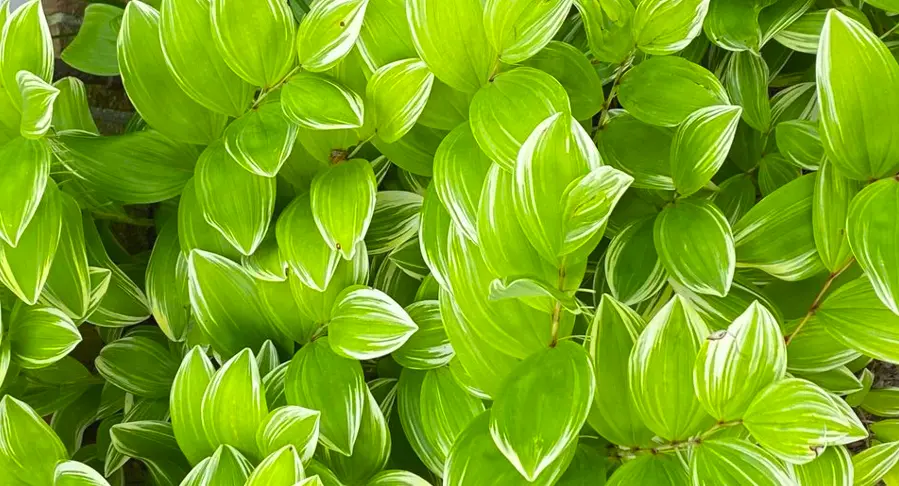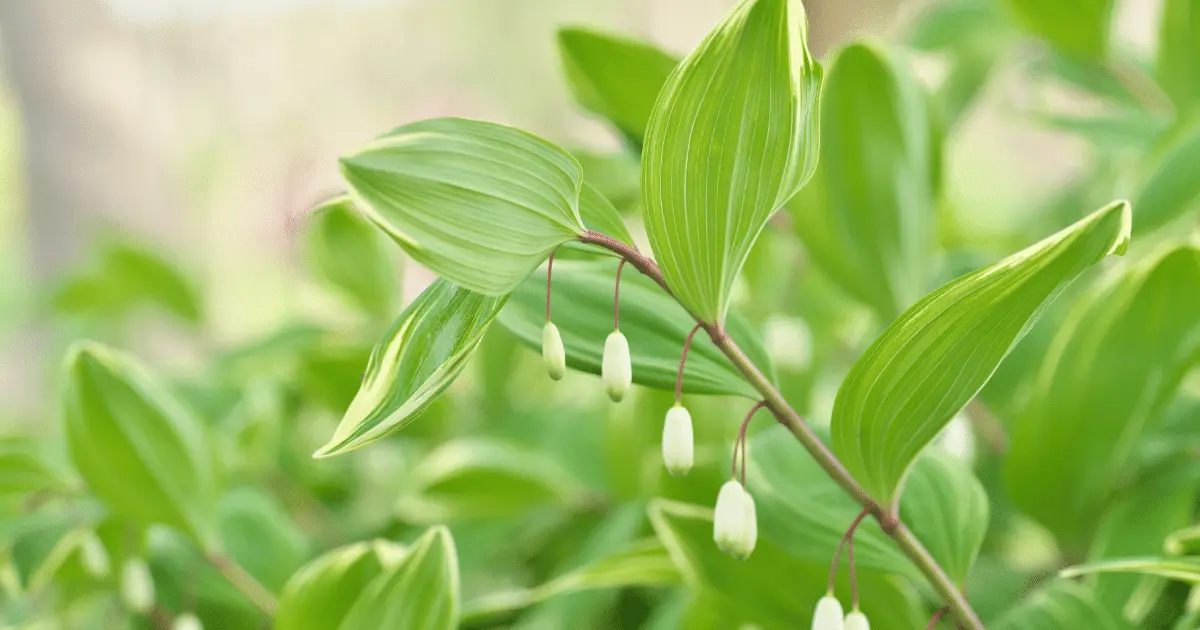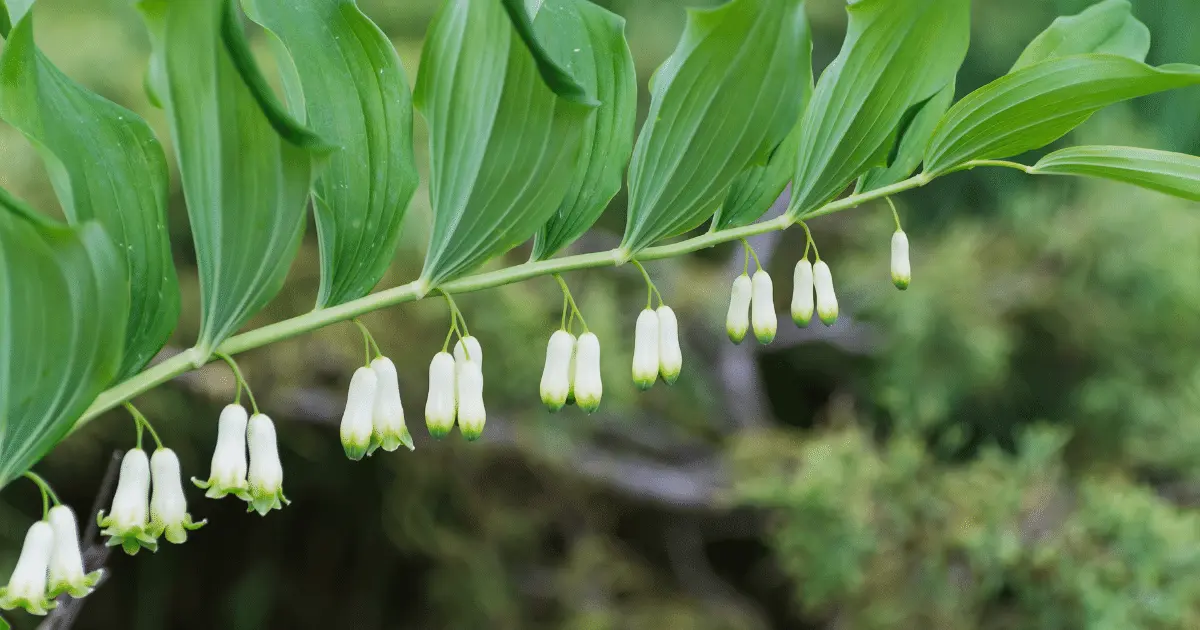Solomon’s seal, also known as Polygonatum, is one of the most common perennials in home gardens today. You should consider growing variegated Solomon’s seal if you want a houseplant that’s low maintenance, easy to grow, and beautiful all year long.
While you can purchase them from a nursery or as cuttings from your garden, you must learn how to properly grow and care for variegated Solomon’s seal if you want yours to thrive. Here’s all you need to know.
What is a Variegated Solomon’s Seal?

Solomon’s seal is a perennial plant native to temperate forests across Eurasia and North America. The plant belongs to the family Polygonaceae and is closely related to rhubarb and buckwheat. The common name refers to the mythical healing properties of the seal’s root, which was first documented in the Bible.
The variegated form is a cultivar artificially selected for its striking white-and-green leaf coloration and is often grown as an ornamental plant. Solomon’s seal is typically grown in USDA zones 4-8, though it can be grown annually in warmer climates. It prefers moist, well-drained soil and grows best in rich soil with mixed compost.
Like other perennials, it is often planted in the fall for growth and flowering the following spring and prefers humus-rich soil with good drainage. Solomon’s seal is a shade-tolerant plant best grown underneath deciduous trees. However, you can plant them in shadier spots underneath dense shrubs or partial shade under evergreen trees.
Where Does Variegated Solomon’s Seal Grow Best?
One of the most important considerations regarding variegated Solomon’s seal is where you should plant it. This plant does best in partial shade, which is unsuitable for sunny areas. Always remember to cultivate it in moist, well-draining soil. It needs to be planted in an area with at least four hours of sunlight each day for optimal growth. If you live in a cold climate, consider mulching around the base of the plant during winter to provide additional protection from the elements.
Varieties of Solomon’s Seal
The Polygonatum genus has more than 60 species, albeit only a limited number of them are frequently grown for garden use. The following are some common garden varieties:
1. Polygonatum odoratum thunbergi

This variety, also known as the Japanese Solomon’s or fragrant Solomon’s seal, is native to Japan and reaches 18 to 36 inches tall. It has fragrant white flowers and reddish stalks and grows hardy in zones 4 to 8. This plant has various cultivars, including ‘Variegatum,’ ‘Lemon Seoul,’ ‘Flora Plenum,’ and ‘Fireworks.’
2. Polygonatum multiflorum

This species is native to Europe and is an outstanding short selection with creamy evergreens on reddish stalks that reaches a height of fewer than 2 feet. Furthermore, it is hardy in USDA zones 4 through 8.
3. Polygonatum ‘Prince Charming’
This variety grows to approximately a foot tall and spreads 2-3 feet wide. Plants with ‘Prince Charming’ blooms bloom at a younger age than many other Solomon’s seal kinds and have greenish-white flowers. This variety is assumed to be a natural hybrid between Polygonatum humile and Polygonatum biflorum.
4. Polygonatum humile
Also known as the dwarf species, this variety is native to Japan and China. It only grows 6 to 9 inches tall and has huge blooms for its height rather. It is, however, only hardy in USDA zones 6 to 9.
5. Polygonatum biflorum
Also called silky Solomon’s seal, this North American native grows around 1 to 3 feet tall. The plant has white-green blooms and smooth leaves on both sides. It is suitable for small gardens and grows well in USDA zones 3 to 9. Polygonatum biflorum variegata commutatum (giant Solomon’s seal) grows over 6 feet tall and repopulates in large groups.
Tips for Growing Variegated Solomon’s Seal

Growing variegated Solomon’s seal is as easy as planting it in some soil and letting it take over your garden. Once the plant has established itself, you can let it grow as a ground cover or prune it to create a beautiful walking path. When planting variegated Solomon’s Seal, it’s important to give it enough room to spread out. The plant’s roots will grow quickly, so give it plenty of space.
Finally, remember to divide Variegated Solomon’s Seal every few years. It is a fast-growing plant that can quickly become overcrowded. By dividing it, you will ensure that each clump has enough nutrients and space to thrive. With proper care and attention, Variegated Solomon’s Seal will reward you with vibrant growth and stunning blooms for many years.
Growing Conditions for Variegated Solomon’s Seal
Soil
A well-drained soil with a pH range between 5.5 and 6.5 is ideal for variegated Solomon’s seal. Soils with higher clay content or sand tend to be better for the plant. Avoid soils with excess organic matter, which can promote disease. If your soil lacks nutrients, you can amend it with compost to improve it.
Sunlight
Partially shaded areas with a few hours of sunlight daily are best for the variegated Solomon’s seal. If your plant is receiving full sunlight, it is likely too hot or dry and should be re-planted in a shadier area.
Watering
Ensure to water your variegated Solomon’s seal when the soil is dry, but not so much that it becomes overwatered. Water more frequently if you notice your plant wilting in the afternoon heat. Avoid overwatering your plant, as this can promote fungal diseases.
Fertilizing
Variegated Solomon’s seal does not require fertilizer, as it does not require much nitrogen. Excessive fertilizer can harm the soil’s microbial life, reducing the soil’s ability to hold water and promote plant growth. Solomon’s seal is a low-maintenance plant that does not need frequent fertilization. If you notice signs of nitrogen deficiency, such as yellowing leaves, you can add fertilizer to the soil, but do so sparingly.
Pruning
Pruning is not necessary for growing Solomon’s seal. However, if you want to control the size of your plant, prune back stems and side shoots as they grow. Pruning can also help in removing wilted leaves and slow growth.
Propagating Variegated Solomon’s Seal
Propagating Solomon’s seal is simple and can be done in several ways. Variegated Solomon’s seal, like other plants that develop from spreading rhizomatous roots, is easy to grow using rhizome divisions. Here’s how:
- Scoop up the parent plant in the spring as new growth emerges. Slice pieces of the plant’s rhizome using a sharp knife or shovel.
- As this plant prefers partial to full shade, choose a spot in your garden where it will get partial to full shade.
- Prepare the soil in the chosen spot by removing weeds, breaking up any large clumps of soil, and amending the soil with organic matter like compost or aged manure.
- Your plant’s root ball should be twice as wide and deep as the hole you dig. Place the root ball into the hole and fill it with soil, tamping it down lightly to avoid air pockets.
- Water the plant thoroughly after planting to keep the soil evenly moist throughout the growing season.
- Fertilize your variegated Solomon’s Seal once or twice during the growing season with organic fertilizer or a balanced 10-10-10 fertilizer.
- Prune back dead or damaged foliage and spent flower stems throughout the growing season.
- In late fall, mulch around your variegated Solomon’s Seal with a 2-3 inch layer of compost or aged manure to help protect it over the winter months.
Caring for Variegated Solomon’s Seal
Variegated Solomon’s seal is easy to care for and often grows as a weed, so it is not too demanding. The plant can grow in various soils and conditions, making it ideal for beginning gardeners. The plant prefers moist soils with a pH between 5.5 and 6.5.
The variegated Solomon’s seal thrives in different soil types, but its preferred soil is neutral to slightly alkaline and can tolerate both wet and dry conditions. Solomon’s seal doesn’t mind soil type and can grow in various soils, including clay and loam. The plant also grows well in poor and rich soil but not in the sand.
Controlling Pests and Diseases
You can do a few things if your plant shows signs of pests or diseases, such as wilting leaves or brown spots on the leaves. Lift the plant, and inspect the soil around the roots. If you notice pests like mealybugs, slugs, snails, or other pests, hand-remove them. Then, sterilize your trowel by boiling it to remove weeds and pests from the soil around the roots.
You can use a few biological pest controls to help manage pests in the soil. Some common diseases that affect your variegated Solomon’s seal include nematodes, bacteria, or fungi. You can use a fungicide (organic or non-organic) to help manage the problem.
Variegated Solomon’s seal is an easy-to-grow perennial perfect for beginning gardeners. It grows in partial shade with moist soil and produces lovely violet flowers. The variegated form is a popular ornamental plant and makes a great addition to any garden. With proper care and maintenance, it can grow into a large, beautiful plant that lasts for years.
